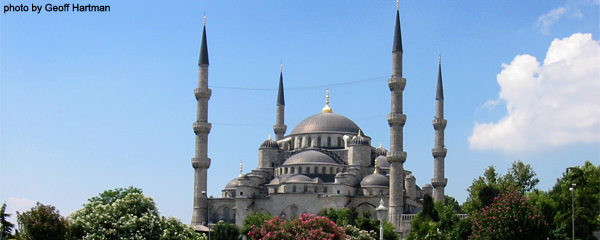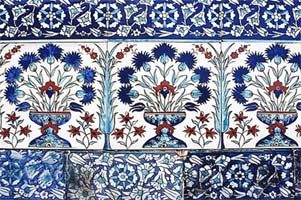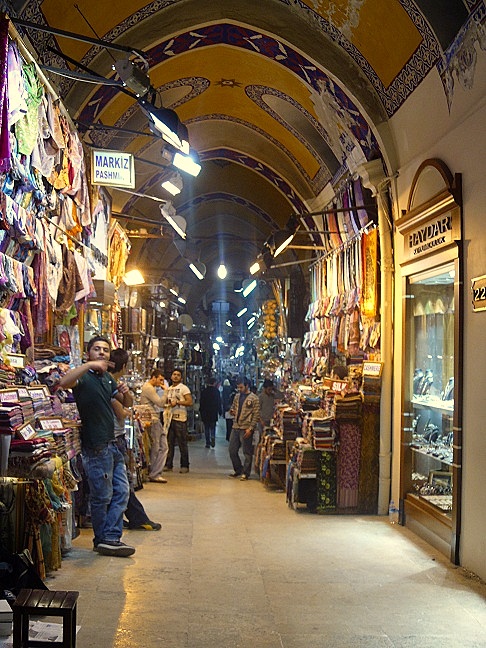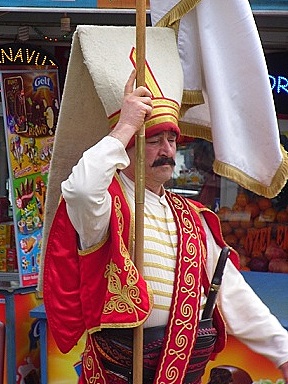
photo by Geoff Hartman
by Amanda Oosthuizen
I needed a break. I needed a different perspective. So did my daughter Lil, before those crazy days of GCSEs began. I searched the Internet for bargains and came up with four nights Istanbul in April. It would be an adventure. We would see the world with new eyes, searching for secrets and exotic settings for short stories.
Although both were last-minute trips, some research beforehand was essential. For the trip to Istanbul I gleaned historical, cultural and practical information from the Internet and various guide books including Virginia Maxwell’s excellent Lonely Planet Cityguide and also the brilliant Rough Guide to Istanbul, not forgetting DK’s Top Ten Istanbul. I’m totally ignorant when it comes to the Turkish literary scene but discovered Istanbullu novelist, Orhan Pamuk who gives a fascinating insight into a certain privileged way of life in the city. I also dipped into Talat Halman’s Living Poets of Turkey – lots of love poetry – and watched Three Monkeys, Nuri Bilgi Ceylan’s evocative film set in Istanbul dealing with power and corruption. I took a Kindle equipped with various useful, interesting and essential (to me) books and a mini laptop, our hotel had good wifi so I wrote bulletins and emailed them to friends; this also helped to focus my thoughts.
Whilst I don’t intend to use these ingredients to force a story, together they form a kind of engine where they can rub together and create the spark to set a story in motion. I want setting to become an integral part of the story, another character as it were. These are some of the notes, impressions and thoughts that will trigger memories:
Scraping and rubbing until you feel invisible.
* The Hamam – open from 6 a.m. until midnight! Why? The scents and heat and steam, the light streaming through the tiny windows in the dome, the historic surroundings – columns, gothic arches and colonnades, the ritual of casting off of your clothes and the vulnerability of wearing only the plain starched cotton pestamal. Stretching out on the great marble slab, the scented oils bright like citrus and complex like rose. The silver bowls overflowing with frothy soapsuds. The scrub. Scraping and rubbing until you feel invisible. The soap wash. New skin. The ancient marble basins. The copper sluicing bowls. The ornate brass taps. The quiet people.
* Conflict, Contrast and Separatism – Europe/Asia, Ottoman/Nineteenth Century – the different sectors of Istanbul: the modern part (rather belle époque Paris), and the ancient part with surprising wooden villas (rather New England). The film students questioning us about how Europeans view Istanbul and what we would change (as if we knew). Moslem/Christian: the reverent solemnity and concentrated beauty of the mosques, in contrast to the crazy noise of children, the silent creeping cats on the altar and the immense, market-hall vastness of the Byzantine church of Hagia Sofia. Atmosphere: the crush and bustle of the bazaars and streets; the quiet spacious mysteriousness of the hamam; the misty tiled domes of the mosques; walking in the underground cistern (a vast, dark and mysterious golden wonder this, with great brown shadowy carp swimming beneath our feet); Istanbul Modern – based on Tate Modern but with mostly Turkish modern art – and a painting of self-flagellating dervishes with axe-wounds in their heads.
* Tulips everywhere, in bloom in their orange, yellow and red thousands, everyone is mad about them: taking close-up photos, family photos, all kinds of photos. It’s one of Istanbul’s traditional symbols and features repeatedly in Ottoman ceramics and carpets. We even visited (by mistake) an exhibition of the tulip in art throughout the ages! Spot the tulip!
* Music – it seeps beneath your skin and you find yourself humming along to strange modal melodies that you didn’t know you knew.
 * The Harem – the golden cage – vast quarters including a hospital, school, hamams, and the sultan’s suites. One guide described this place as ‘family quarters’. Here were housed the Sultan’s wives, children (one sultan had over 700), his mother (the Valide Sultan), his concubines and odalisques. Girls who were considered particularly beautiful and intelligent, especially from the Balkans, Poland and Sudan, were captured and imprisoned here as slaves. At Topkapi, all were guarded by a troupe of black eunuchs (black eunuchs had their entire genitalia removed, whereas white eunuchs were only partly castrated). Neither eunuchs nor women were free to leave. When fratricide was abolished, brothers of the sultan were kept in the harem from a very young age, ending up mad or desperately cruel – one, when released, threw two hundred concubines off the cliff into the Bosphorus. Female slaves were sold until 1908.
* The Harem – the golden cage – vast quarters including a hospital, school, hamams, and the sultan’s suites. One guide described this place as ‘family quarters’. Here were housed the Sultan’s wives, children (one sultan had over 700), his mother (the Valide Sultan), his concubines and odalisques. Girls who were considered particularly beautiful and intelligent, especially from the Balkans, Poland and Sudan, were captured and imprisoned here as slaves. At Topkapi, all were guarded by a troupe of black eunuchs (black eunuchs had their entire genitalia removed, whereas white eunuchs were only partly castrated). Neither eunuchs nor women were free to leave. When fratricide was abolished, brothers of the sultan were kept in the harem from a very young age, ending up mad or desperately cruel – one, when released, threw two hundred concubines off the cliff into the Bosphorus. Female slaves were sold until 1908.
* People – the crazy boy at the T-shirt stall who asked me how many camels I wanted for my daughter and his friend who said she’d be far too expensive for him; Florence Nightingale (a regular at one of the hamams); the calm confidence and bright scent of men passing in the street who had visited the hamam; the courtesy – the bows and politeness and good humour. The tulip sellers.
* The Grand Bazaar, the Spice Bazaar – places to get lost in, like walking through tunnels full of scents and sounds: a man playing the whining, throaty durum pipes; the creamy Turkish Delight; the shady corners and domed lobbies; baskets, sacks, tubs of spices – the scent of cardamom and cinnamon; the serious men drinking apple tea and the waiters running between them with their silver trays; the jewellery; the books; the leather goods; the gold; the evening gowns. The grainy coffee, the kebabs, and the pomegranate juice vendors.
sounds: a man playing the whining, throaty durum pipes; the creamy Turkish Delight; the shady corners and domed lobbies; baskets, sacks, tubs of spices – the scent of cardamom and cinnamon; the serious men drinking apple tea and the waiters running between them with their silver trays; the jewellery; the books; the leather goods; the gold; the evening gowns. The grainy coffee, the kebabs, and the pomegranate juice vendors.
* Ritual – haggling for everything; invitations from shopkeepers; the awkwardness of the hamam; belly dancing on TV and in tourist shows; the white-skirted dervish whirling in the cafe; the kind receptionist at the hotel taking us for tea.
* The Palaces, Mosques and Mausoleums – the sumptuousness of the newer palaces: the crystal balustrade; the gold; a forty ton chandelier; marble toilets, piano after piano after piano in the new harem. The tiled mausoleums – so many and so silent – occupied by one sultan or another, his wives and his children. White turbans on the tombs (the bigger the turban the more important the tenant), or the fez. The call to prayer echoing from mosque to mosque; the virtuoso muezzin; three old women rushing to wash their feet as the call sang out; the borrowed blue headscarves; the aggressive mosque attendants.
* The Sea – our trip up the Bosphorus by public ferry to the Black Sea: ships everywhere; the peace of a fishing village; schoolgirls in blue tartan uniforms; a delicious fish lunch high up in the mountain cafe.
* Language – also sumptuous in what is probably translation: the Divan (the Ottoman Government – and yes, they sat on large upholstered benches); the Grand Vizier (chief of the Ottoman parliament); trying, to the amusement of the Turks, to twist my tongue around their language. And the tulips.
 Istanbul is a seductive place, full of dilapidated Ottoman palaces and glimpses of a thousand ships. When passing between buildings, it is as if the sea is filling all the spaces in between. Istanbul is a place where you stumble across ceramics of breathtaking beauty and your eyes and brain are shaken by the intricate patterns of the rugs, tiles, ceilings and floors. There is history, manners, ritual, wherever you go.
Istanbul is a seductive place, full of dilapidated Ottoman palaces and glimpses of a thousand ships. When passing between buildings, it is as if the sea is filling all the spaces in between. Istanbul is a place where you stumble across ceramics of breathtaking beauty and your eyes and brain are shaken by the intricate patterns of the rugs, tiles, ceilings and floors. There is history, manners, ritual, wherever you go.
The story I write will be a sensual story. I can imagine a scene at ten to midnight in the steamy hamam. There will be violence or cruelty. I can sense a conflict between the characters, perhaps religious; my main protagonist will be a woman I think perhaps in a relationship with a difficult, over-confident man. On the plane there, I sat next to a young bright-eyed English woman who was met by a Turkish aunt, so perhaps there’s a European vs Traditional internal conflict to be discovered in my story. I will try to make patterns with ideas and language, and set my mind roaming along the backstreets to see how those patterns connect. As for characters, it has to be about a man and maybe two women. I can see the man, clearly. He’s tall, and I think I caught a glimpse of the back of his head as he passed me on the street, fragrant and shiny, straight from the hamam.
I witnessed a little scene where a young woman in grey was leaving a man and she waved her hand a little by her knee, and they parted awkwardly with no agreement to see each other again. I will wonder where she’s going next. Perhaps it will be a reversal, two men and one woman. And then there are the tulips, so many tulips…


Amanda,
Thrilling expo. I love your passion for the Short Stories, and really have enjoyed reading some of your articles. I do enjoy your compare of culture and livelihood, thanks for sharing.
___
Mike at Portable Toilets